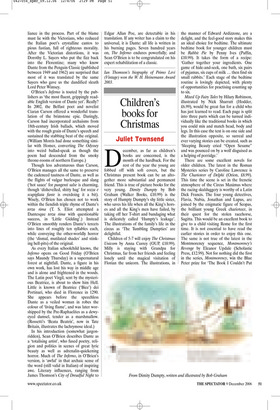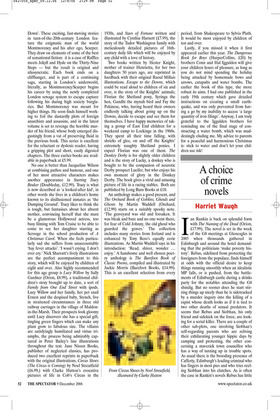Children’s books for Christmas
Juliet Townsend
December, as far as children’s books are concerned, is the month of the hardback. For the rest of the year the young are fobbed off with soft covers, but the Christmas present book can be an altogether more substantial and permanent friend. This is true of picture books for the very young. Dimity Dumpty by Bob Graham (Walker Books, £10.99) is the story of Humpty Dumpty’s shy little sister, who saves his life when all the King’s horses and all the King’s men have failed, by taking off her T-shirt and bandaging what is delicately called ‘Humpty’s leakage’. The illustrations of the family’s life in the circus as ‘The Tumbling Dumpties’ are delightful.
Children of 5-7 will enjoy The Christmas Unicorn by Anna Currey (OUP, £10.99). Milly is staying with Grandpa for Christmas, far from her friends and feeling lonely until the magical visitation of Florian the unicorn. The illustrations, in the manner of Edward Ardizzone, are a delight, and the feel-good story makes this an ideal choice for bedtime. The ultimate bedtime book for younger children must be Rabbit Pie by Penny Ives (Puffin, £10.99). It takes the form of a recipe: ‘Gather together your ingredients. One game of hide-and-seek, one bath, six pairs of pyjamas, six cups of milk ... then find six small rabbits.’ Each stage of the bedtime routine is lovingly depicted, with plenty of opportunities for practising counting up to six.
Mixed Up Fairy Tales by Hilary Robinson, illustrated by Nick Sharratt (Hodder, £6.99), would be great fun for a child who has just learned to read. Each page is split into three parts which can be turned individually like the traditional books in which you could mix and match head, body and legs. In this case the text is on one side and the illustration opposite, so surreal and ever varying stories can be created, such as ‘Sleeping Beauty cried “Open Sesame” and was pounced on by a wolf disguised as a helping of porridge.’ There are some excellent novels for older children. The latest in the Roman Mysteries series by Caroline Lawrence is The Charioteer of Delphi (Orion, £8.99). This time the scene is set in the frenetic atmosphere of the Circus Maximus where the racing skulduggery is worthy of a Latin Dick Francis. The four young detectives, Flavia, Nubia, Jonathan and Lupus, are joined by the enigmatic figure of Scopas, the brilliant young Greek charioteer, in their quest for the stolen racehorse, Sagitta. This would be an excellent book to give to a child visiting Rome for the first time. It is not essential to have read the earlier stories in order to enjoy this one. The same is not true of the latest in the Montmorency sequence, Montmorency’s Revenge by Eleanor Updale (Scholastic Press, £12.99). Not for nothing did the first in the series, Montmorency, win the Blue Peter prize for ‘The Book I Couldn’t Put Down’. These exciting, fast-moving stories in turn-of-the-20th-century London feature the enigmatic man of the world Montmorency and his alter ego, Scarper. They draw on elements of some of the best of sensational fiction: it is a case of Raffles meets Jekyll and Hyde on the Thirty-Nine Steps — but the result is original and idiosyncratic. Each book ends on a cliffhanger, and is part of a continuing saga, starting in London’s underworld, literally, as Montmorency/Scarper begins his career by using the newly completed London sewage system to escape capture following his daring high society burglaries. But Montmorency was meant for higher things. He soon finds himself working to foil the dastardly plots of foreign anarchists and assassins, and in the latest volume is set to revenge the horrible murder of his friend, whose body emerged disgustingly from a vat of preserving fluid in the previous book. This series is excellent for the reluctant or dyslexic reader, having a gripping plot and short, easily digested chapters. The three earlier books are available in paperback at £5.99.
No one is better than Jacqueline Wilson at combining pathos and humour, and one of her most attractive characters makes another appearance in Starring Tracy Beaker (Doubleday, £12.99). Tracy is what is now described as ‘a looked-after kid’, in other words she lives in a children’s home known to its disillusioned inmates as ‘the Dumping Ground’. Tracy likes to think she is tough, but fantasises about her absent mother, convincing herself that she must be a glamorous Hollywood actress, too busy filming with Tom Cruise to be able to come to see her daughter starring as Scrooge in the school production of A Christmas Carol. When she feels particularly sad she suffers from unaccountable ‘hay fever attacks’. ‘I wasn’t crying. I don’t ever cry.’ Nick Sharratt’s lively illustrations are the perfect accompaniment to this story, which will be enjoyed by children of eight and over. Also highly recommended for this age group is Lucy Willow by Sally Gardner (Orion, £8.99), a traditional children’s story brought up to date, a sort of Family from One End Street with ipods. Lucy Willow and her family, her pet snail Ernest and the despised baby, Stench, live in straitened circumstances in three old railway carriages in the village of Maldonin-the-Marsh. Their prospects look gloomy until Lucy discovers she has a special gift, tingling green fingers which can make any plant grow to fabulous size. The villains are satisfyingly humiliated and virtue triumphs, the process being admirably captured in Peter Bailey’s line illustrations throughout the text. Jane Nissen Books, publisher of neglected classics, has produced two excellent reprints in paperback with the original illustrations, Circus Shoes (The Circus is Coming) by Noel Streatfield (£6.99,) with Clarke Hutton’s evocative pictures of life in Cob’s Circus in the 1930s, and Stars of Fortune written and illustrated by Cynthia Harnett (£7.99), the story of the Tudor Washington family with meticulously detailed pictures of 16thcentury daily life which will be enjoyed by any child with a love of history.
Two books written by Hester Knight, mother of trainer Henrietta, for her two daughters 50 years ago, are reprinted in hardback with their original Raoul Millais illustrations. Escape to the Downs, which could be read aloud to children of six and over, is the story of the Knights’ animals; Florian the Shetland pony, Syringa the hen, Gandhi the mynah bird and Fay the Pekinese, who, having heard their owners endlessly talking about going up on the Downs, decide to escape and see them for themselves. I have happy memories of taking a group of East End children for a weekend camp to Lockinge in the 1960s. They spent all their time falling, with shrieks of glee, on and off the Knights’ extremely naughty Shetland ponies. I expect Florian was one of them. The Donkey Derby is for slightly older children and is the story of Lucky, a donkey who is bought to be the companion of neurotic Derby prospect Lucifer, but who enjoys his own moment of glory in the Donkey Derby. The book gives a vivid and amusing picture of life in a racing stables. Both are published by Long Barn Books at £10.
An anthology makes a good present, and The Orchard Book of Goblins, Ghouls and Ghosts by Martin Waddell (Orchard, £12.99) starts on a suitably spooky note. ‘The graveyard was old and forsaken. It was bleak and bare and no one went there, for fear of Cold Johnny, the old ghoul who guarded the graves.’ The collection includes many stories from Ireland and is enhanced by Tony Ross’s equally eerie illustrations. As Martin Waddell says in his introduction: ‘Read, shiver, wonder ... enjoy.’ A handsome and well chosen poetry anthology is The Barefoot Book of Classic Poems, compiled and illustrated by Jackie Morris (Barefoot Books, £14.99). This is an excellent selection from every period, from Shakespeare to Sylvia Plath. It would be most enjoyed by children of ten and over.
Lastly, if you missed it when it first appeared earlier this year. The Dangerous Book for Boys (HarperCollins, £20) by brothers Conn and Hal Iggulden will give your children hours of pleasure, as long as you do not mind spending the holiday being attacked by homemade bows and arrows, catapults and water bombs. The earlier the book of this type, the more robust its aims. I had one published in the early 19th century which gave detailed instructions on creating a small earthquake, and was only prevented from having a go by my inability to access ‘a large quantity of iron filings’. Anyway, I am truly grateful to the Iggulden brothers for reminding me of the final stage of constructing a water bomb, which was maddeningly eluding me. My advice to parents for a peaceful and harmonious Christmas is: stick to water and don’t let your children use ink!



























































































 Previous page
Previous page